Final_essay_BadExample - IS MU
advertisement
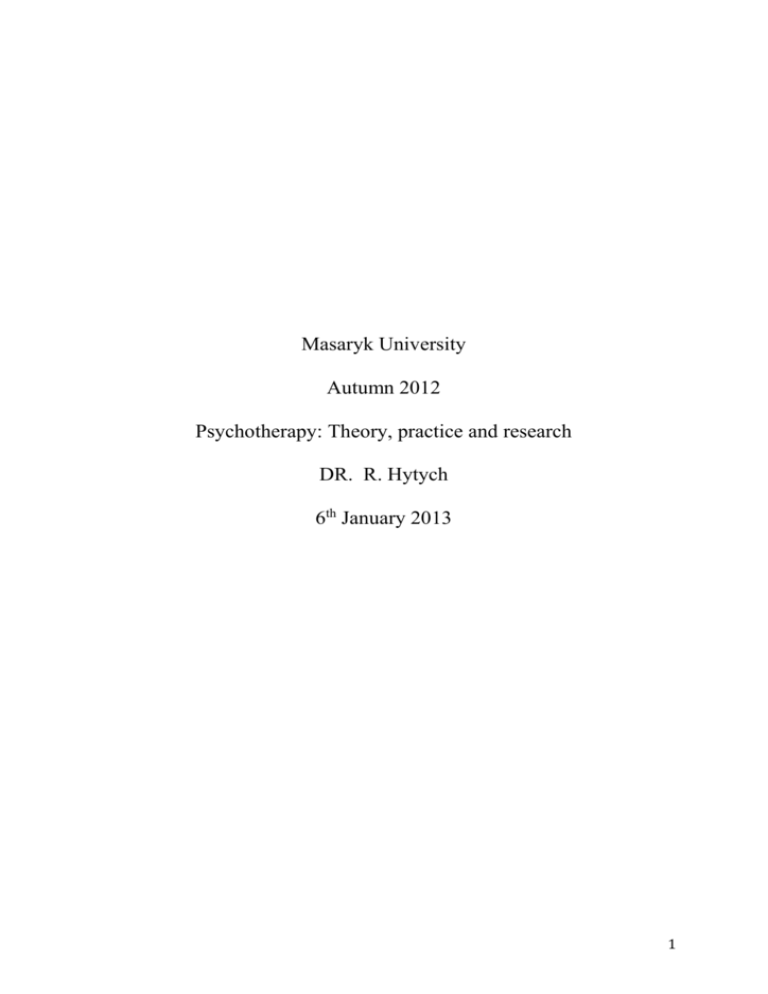
Masaryk University Autumn 2012 Psychotherapy: Theory, practice and research DR. R. Hytych 6th January 2013 1 Psychotherapy : Theory, practice and research Final essay. Main psychotherapy approaches, personalities and training institutes in Belgium. According to the Oxford dictionary, Psychotherapy is “the treatment of mental disorder by psychological rather than medical means”. A Psychologist who determines that a person needs a psychological assistance generally prescribes psychotherapy. This assistance is generally prescribed when a person suffers from an emotional discomfort, or a deep continuous stress, or mental disorders. There are different approaches in psychotherapy. Each of them uses a different way to apply the treatment. There are more or less hundred different kinds of approaches in this discipline. The most famous are the Psychoanalytic approach, the cognitivebehavioral approach, humanist approach and the systemic approach. There are a lot of approaches and it is important to define some rules in each approach to be sure that there will be no abuses. Because it is easy to “create” a new approach and there are approximately an approach on each problematic situation of the life and a way to control the painful of this situation. It could be interesting to specify the differences between a psychiatrist, a psychologist, a psychotherapist and psychoanalyst because in Belgium these different professions are sometimes mingled. The politics about the psychotherapy is nowadays still confused and unfortunately almost anyone can claim that he is a therapist. A psychiatrist : A Psychiatrist is a medical doctor who has made a specialization in Psychiatry for children, adolescents or adults. They can make prescriptions for people who have mental diseases. An interesting point is that this discipline is covered by insurances. The law protects the psychiatry. A Psychologist : A Psychologist is a professional of the mental health. To be Psychologist, it is necessary to study five years Psychology at the University and realize a master in Psychology. The law also protects the profession. A Psychotherapist and a Psychoanalyst : 2 They are the most of the time psychiatrists or Psychologists. They have made a specialized training after the University. They can realize their training in different school. During the training, the Psychotherapists and the Psychoanalysts have to realize a personal psychoanalysis. As it is specified at the beginning of this essay there a lot of different approaches in Psychotherapy. Each Psychotherapist choose the approach that he feels the most closer. There is also an interesting observation: the most of the country use their specific approaches. Different current of thought influences each country and this is this influence that make that each country use different approaches in Psychotherapy. After various researches, there are three main approaches, which are used in Belgium. There are the Psychoanalysis, the systemic therapy, and the cognitivebehavioral therapy. These approaches are the most used in Belgium and the most learned in our University. Main approaches in the Belgian Psychotherapy : PSYCHOANALYSIS: + Historic : In Belgium, there are three main characters that have had an impact in the creation of the Psychoanalysis. By their interest in Psychoanalysis they created the Belgium Society of Psychoanalysis. The founders of the Psychoanalysis in Belgium are Mr. Dugautiez, Mr. Lechat and Mrs. Lechat-Ledoux. Mr. Dugauthiez: Dugauthiez was a Belgian Psychoanalyst. He was born in 1893 and he dies in 1960 in the capital of Belgium: Bruxelles. At first he was interested about the hypnosis and the suggestion. His deep interest for the Psychoanalysis started when he met Mr. Lechat and Mrs. Lechat-Ledoux. They established a lot of contacts with the psychoanalysis society of Paris and from this relation they created on the 24th December 1946 the Belgian society of Psychoanalysis. Mr.Lechat and Mrs. Lechat-Ledoux: 3 Ferand Lechat and Mrs. Lechat-Ledoux were Belgian Psychologists and Psychoanalysts. Mr. Lechat was born in 1895 at Mont-sur-Marchienne and he dies at Bruxelles in 1959. Lechat was an expert in the Rorschat test and a brilliant expert in didactic. During the First World War he was deeply injured and in consequence of this damage he began a didactic analysis with the Dr. Hoffman. Mr. Lechat and Mrs. Lechat-Ledoux were member of the Psychoanalysis society of Paris. By creating the Belgian Society of Psychoanalysis with Dugauthiez they influenced nowadays a lot of young Psychoanalyst. The Belgian society of Psychoanalysis is the result of the meeting between Hoffman and these three important Belgian Psychoanalysts. This is the main Belgian institution to realize a training in Psychoanalysis. This institution is recognized by the international Psychoanalysis association (IPA). This institution includes nowadays more or less 130 members. The first half of the members are doctors and the second part are psychologists .The structure of this institution is very organized. Twice a month there are scientific seminars and there are also work groups who have the responsibilities to do some researches in the institution. In the institution, there are different thoughts. This diversity is influenced by the beliefs of psychotherapists. It depends about the approaches that the scientists use and have learned at the University. Those different ways to think allow the discussion and also give new perspectives of researches. The purpose of the Belgium society of psychoanalysis is to realize a link between THEORY and CLINIC. All the researches are represented in the magazine called “La revue belge de Psychanalyse”. In reaction of the researches and the discoveries from the Belgium society of psychoanalysis an ethics committee is created in 1988. It includes all the ethics values concerning the psychoanalysis. + To conduct the interview: There are different ways to realize a psychoanalysis maintenance. The first one is the basic representation of a maintenance this is the “chair and the couch”. During the session the client is lying down on the couch and he has to explain all his thoughts. The client tells all his thoughts freely. In this way the psychoanalyst is not in a direct relation with his client. This method is called “la libre association” (“free association”). The second way to realize psychoanalysis maintenance is the “Face to Face”. 4 Some people need to be in a direct relation with the psychoanalyst to feel his consideration, to think and elaborate his thoughts. This way to act is useful when people are in a difficult situation or when the past affects the present. The third one is the “maintenance by group”. The group allows elaborating our difficulties when we can’t explain what we feel. The fact to hear the problems from the other people can help us to find our words and try to explain what we feel and our problems. To conclude there are three ways to realize the maintenance. Each ways are specific for each people and also for each special event that we can have during the life. THE SYSTEMIC THERAPY 5 + Historic: Mony Elkaïm allowed developing the systemic therapy in Belgium. He creates in 1970 a movement against the psychiatry called “antipsychiatry” in Europe. He is actually professor at the ULB (main University in Bruxelles) and he forms some psychotherapists from Europe, USA and Canada. + Characteristics of the systemic therapy: The systemic therapy can be a unique consultation or multiple consultations that include minimum two people who comes from the same life context. It includes also several people who have the same pain; it means that they share the same common destiny. The systemic therapy is born to answer to violent behavioral and mental situation involving several members of the same family. These problems have often serious consequences on the social environment. This therapy allows focusing on the psychotic troubles, on eating disorders, on addiction, abuse on children, and violence in family. The purpose of this therapy is to understand the pain and the system in which the patient developed. The problem has to be understood by an intra-conjugal or an intra-familial way. In systemic the therapist is not neutral, he is active in the relation that he tries to create with the patient (Therapist-patient), with the couple (therapistcouple), or with the family (therapist-family). In this sense, the therapist is not really objective because sometimes he can give to his patient an advice or a suggestion but he keeps in mind all the time the purpose of the patient, his autonomy and his personality. During the session the therapist is concentrated on the communication between the members of the family or of the couple. He uses more a metaphoric language than an intellectual language to facilitate the comprehension and the problem solving. The therapist must: - act with empathy - have an active listening - be kindly - be without judgments + Main institution in systemic therapy in Belgium: 6 IDRES Resources institution of documentation and from systemic studies. This institution is a place that includes resources, exchange and researches in systemic. This institution is born in 1977 by therapists who wanted to share their experiences with the family that they have met. Systems and family of study center: (SEFC) This is a website used by the therapists who want to compare their work experiences with their family and elaborate new approaches. 7 THE COGNITIVE-BEHAVIORAL THERAPY ( CBT) + Origin : The origin of this therapy comes from the learning theory: it means from the operant conditioning, from the classical conditioning and from the social learning. This therapy is reputed in Europe and often used in therapy. The CBT is officially recognized sins 1960 with the association of the cognitive-behavioral therapy. + Training of the cognitive-behavioral therapists: The training of this discipline concerns the psychologists, the psychiatrists, and the general practitioners who have a good knowledge in psychiatry. There is different criterion during the training that the therapist has to realize. First one, he has to follow a university education. Secondly he has to follow a training of 450 hours and he has to be supervised by a professional therapist during 200 hours (it means height different cases and three different kinds of problem). The therapist should have also a continuing education during his entire career. + Organization of the therapy: The therapy can be individual, by group, by couple or by family. One session is more or less from 30 to 60 minutes long. + Generally a therapy includes: - from 10 until 25 weekly sessions for the anxiety disorders and the depression. - more or less hundred sessions for the personality disorders. During the therapy, the therapist is active. He asks different specific questions on the problems that his patient suffers. In this way, he tries that his patient realizes and understand by himself his own problems. The therapist helps also his patient by different repetitions about what the patient said during the session. He summarizes the words of the patients and in this way the patient can have a global representation of his thoughts. At the end of each session, the therapist and the patient chose the topic that they would like to talk on the next session. + The technics used during a therapy are - The problem solving - Learning the management of trauma: in this way the patient will stop to deny the problem and to suffer when he thinks to a souvenir. 8 - Used role-play that allows regulating his emotions. + Therapeutic framework: The therapy includes different steps: 1) Motivational analysis: the therapist tries to find the characteristics that the patient would like to change and define the objectives of the treatment. 2) Therapeutic alliance: establish a collaboration between the therapist and the patient. 3) Functional analysis: The objective of this part of the therapy is to define the behavior problems and to do a link between the emotions and the thoughts. 4) Explication of the problem psychopathologic that the therapist will use to change the behavior of his patient, his emotions and his thoughts. 5) At the end of the therapy there is an evaluation of the treatment in comparison of the beginning. 6) The therapist and the patient establish a program and a follow-up during one year after the active treatment. To summarize this presentation about the main approaches in Belgium. Firstly I would like to give my personal opinion. These different researches on the main approaches that are included in the psychotherapy have influenced my reflection about the psychotherapy. If I had the occasion to become a psychotherapist I think that I will be closer with the systemic approach. This approach inspires me by the fact that I like to be in relation with people and communicate with them. The systemic allows being in relation with minimum two people (a couple) or more. I think that the exchanges have to be more prolific and rewarding. Secondly I think that it is really difficult to stay in one approach during all his professional life because our career will be influenced by the people (our patients, the other therapists and the researchers) that we are going to meet during our professional future and also by the new discoveries. The richness of the psychotherapy has evolved since different generation until today to influence a lot of young Psychotherapists. It will be great if nowadays the psychotherapy could be more taken into consideration because I have still the impression that people have the feeling that going to a psychotherapist is something wrong. I hope that the mentality could still change. 9 References: - Liévin, V. (2012). La maison de la Société Belge de la Psychanalyse. On line http://blogs.rtl.be/santevousbien/2012/06/08/la-maison-de-la-societe-belge-depsychanalyse/ - Société Belge de Psychanalyse. «s.d». On line http://www.psychoanalyse.be/Public/Website.php?ID=3270 - Gabriel. M. «s.d». Les thérapies familiales et systémiques. On line http://www.lepsychologue.be/psychologie/therapies-familialessystemiques.php?PHPSESSID=45476833e875c5a2036c13264c64d8a2 - Ford, D. H., Urban, H. B. (1998). Contemporary models of psychotherapy : A comparative analysis (2nd ed.). New York, NY : John Wiley & sons, Inc. - Canceil, O. Cottraux, J. Falissard, B. Flamand, M. Miermont, J. Swendsen, J. Teherani, M. Thurin, J.M. (2004). Psychotherapye : Trois approches évaluées. Paris : Inserm. 10


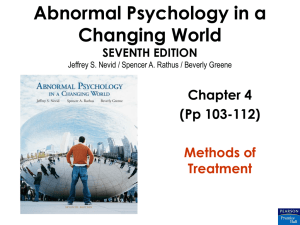


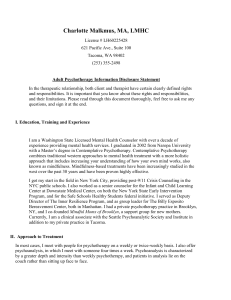
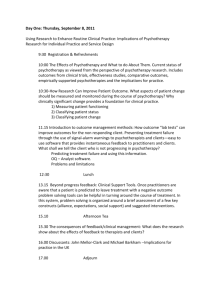
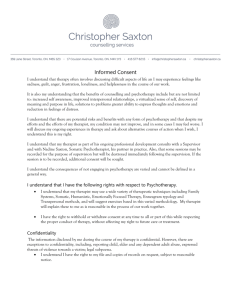
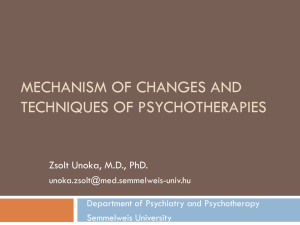
![UW2 - Psychiatric Treatments [2014]](http://s3.studylib.net/store/data/006859622_1-db6167287f6c6867e59a56494e37a7e7-300x300.png)